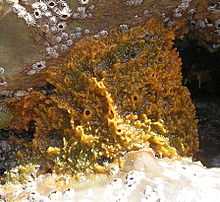Myxilla incrustans
| Myxilla incrustans | |
|---|---|
 | |
| Myxilla incrustans | |
| Scientific classification | |
| Kingdom: | Animalia |
| Phylum: | Porifera |
| Class: | Demospongiae |
| Order: | Poecilosclerida |
| Family: | Myxillidae |
| Genus: | Myxilla |
| Species: | M. incrustans |
| Binomial name | |
| Myxilla incrustans (Johnston, 1842) | |
| Synonyms[1] | |
| |
Myxilla incrustans is a species of demosponge. It is an encrusting species and is usually yellow.
Description
M. incrustans is an encrusting sponge occurring in patches up to 20 cm (8 in) across and 5 cm (2 in) high. It is usually some shade of yellow but can range through orange, pink and white. It has a bubbly-looking appearance with internal channels visible through the surface and large, raised oscules. The consistency is fairly soft and elastic but the surface feels crisp because of the vertical spicule bundles supporting it. The skeleton is built out of tornotes, megascleres with spear-shaped ends with tiny spines on them. The microscleres are a mixture of curved, shovel-like chelae and "C"-shaped sigmas. Several other similar sponges grow in the same habitats and microscopic examination is necessary to identify the species.[2]
Distribution
M. incrustans is found in the Arctic, round Bear Island and the Faroe Islands, on the coasts of Norway and south along the Atlantic coast to the Mediterranean Sea. In these areas it is usually found between low water mark and a depth of four hundred metres on vertical rocks and sites with clean water exposed to strong tidal flows.[2] It also occurs in the north west Pacific Ocean and Japanese waters. Here it is often found growing on the shells of clams in the genus Chlamys.[3][4][5]
Biology
M. incrustans is viviparous and in the months of August and September, developing embryos are sometimes found inside the tissues. These are spherical and measure about 0.5 mm across before becoming detached.[2] Initiation of the sexual processes involved in reproduction depends on the water temperature. The male tissue releases sperm into the water column. These may get sucked into another sponge and then fertilisation take place. 7 to 12% of the maternal tissue of the sponge are used up in the reproductive process and there is some localized destruction of the tissue.[6]
References
- ↑ World Register of Marine Species
- ↑ 2.0 2.1 2.2 Marine Species Identification Portal
- ↑ Rosario Beach Marine Laboratory
- ↑ Heather M. Farren & Deborah A. Donovan. "Effects of sponge and barnacle encrustation on survival of the scallop Chlamys hastata" (PDF). Hydrobiologia 592 (1): 225–234. doi:10.1007/s10750-007-0743-1.
- ↑ On On Lee, Stanley C. K. Lau, Mandy M. Y. Tsoi, Xiancui Li, Ioulia Plakhotnikova, Sergey Dobretsov, Madeline C. S. Wu, Po-Keung Wong & Pei-Yuan Qian (2006). "Gillisia myxillae sp. nov., a novel member of the family Flavobacteriaceae, isolated from the marine sponge Myxilla incrustans" (PDF). International Journal of Systematic and Evolutionary Microbiology 56: 1795–1799. doi:10.1099/ijs.0.64345-0. PMID 16902010.
- ↑ A. V. Ereskovsky (2000). "Reproduction cycles and strategies of the cold-water sponges Halisarca dujardini (Demospongiae, Halisarcida), Myxilla incrustans and Iophon piceus (Demospongiae, Poecilosclerida) from the White Sea". The Biological Bulletin 198 (1): 77–87. PMID 10707815.